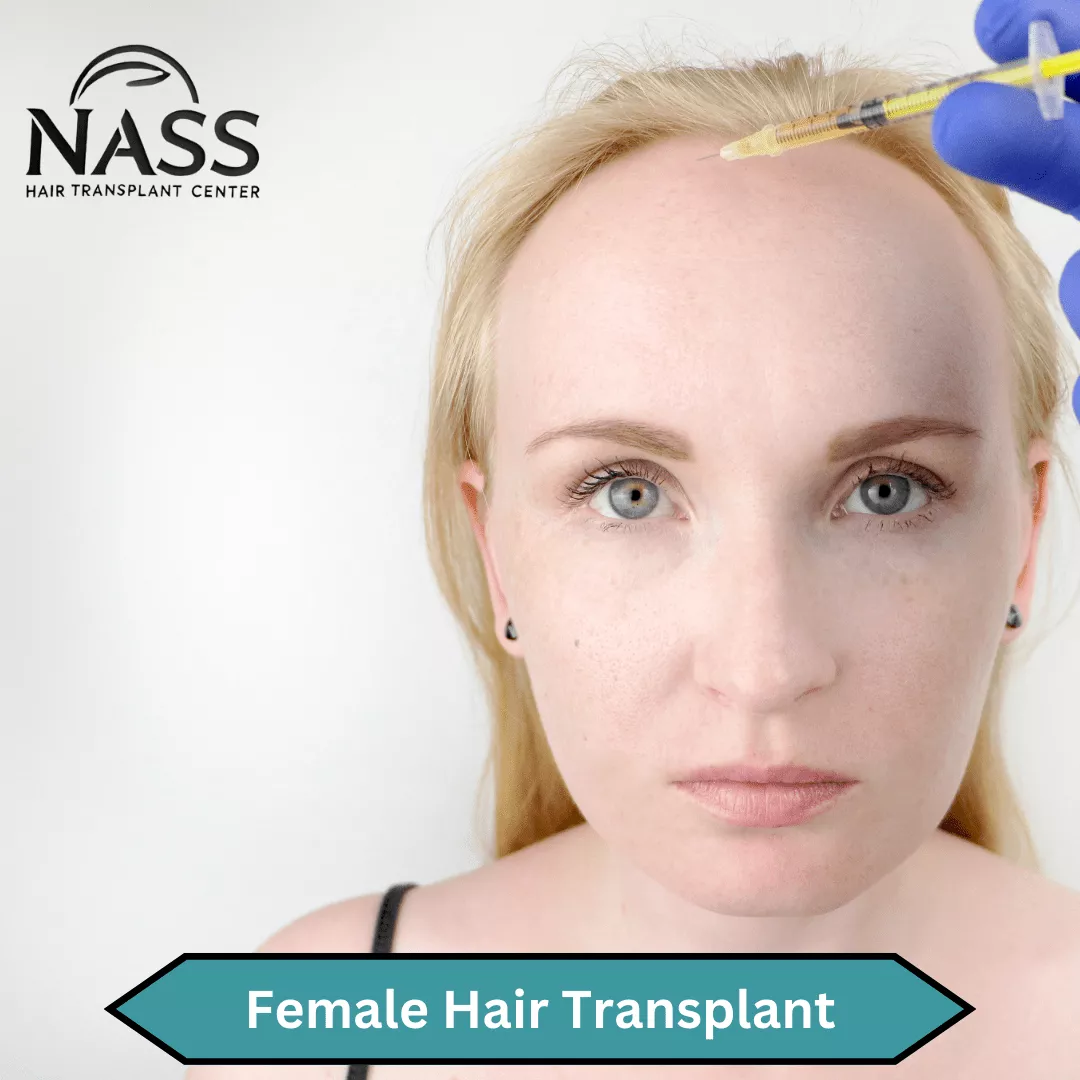Female Hair Transplant In Turkey In our previous article, we covered hair transplantation procedures for men in Turkey. If you’re interested, you can explore that article on Turkish hair clinics. We discussed Prevalent hair loss Therapies , such as the FUE procedure, Sapphire FUE, and DHI hair transplants. Now, we will shift our focus to hair transplantation surgery for women, specifically addressing female hair loss and the advanced Approach involved, like Follicular Unit Extraction (FUE).
What Are the Differences Between female Hair Transplants and for Men?
The differences between hair transplants for women and men largely involve the patterns of hair Fading , the areas of the scalp targeted for restoration, and the Approach s used during the procedure.
Pattern of Hair Thinning:
- Men: Usually Expertise a receding hairline or Hairless spots, especially at the crown, which allows for targeted restoration using grafts.
- Women: Often suffer from diffuse Fading across the entire scalp, making it more challenging to pinpoint specific areas for graft placement.
Giver Area Considerations:
- Men: Usually have a stable Giver area at the back and sides of the scalp, where hair follicles are less affected by hair loss.
- Women: May Expertise Fading even in these Giver areas, requiring careful evaluation to ensure enough healthy follicles are available for grafting.
Surgical Approach:
- Men: Focuses on restoring the hairline and filling in balding areas with denser Buds .
- Women: The approach is often more conservative, aiming to enhance overall density and maintain the Normal hairline.
Cost Considerations:
- Men: The cost can vary Contingent on the number of grafts needed to restore the hairline and balding areas.
- Women: Costs may differ due to the more complex nature of diffuse Fading , which can require a more tailored approach to achieve optimal results.
Understanding these differences ensures that both men and women receive the most effective and Normal -looking hair restoration.

What is the success rate of female hair transplant ?
The Achievement Ratio of female hair transplants is generally high, particularly when performed at an experienced Practice using advanced Approach . Achievement is often measured by the growth of Implanted hairs and the overall satisfaction with the aesthetic outcome.
Treatment Effectiveness:
Female hair transplant procedures, including Follicular Unit Transplantation , Usually yield Achievement rates ranging from 85% to 95%. This effectiveness largely depends on factors such as the extent of hair Fading , the health of the Giver area, and the expertise of the surgeon.
FUT Technique:
This way involves removing a strip of scalp from the Giver area, from which individual follicular Modules are harvested and Implanted . This Approach can be a good option for women with sufficient donor hair, as it allows for a higher number of grafts to be Implanted in a single session.
Clinic Experience:
The Achievement of the treatment also relies heavily on the Expertise of the clinic and the surgical team. An experienced clinic will have the necessary skills and knowledge to perform the procedure effectively, increasing the likelihood of a successful outcome.
long Period
The Implanted hairs Usually begin to grow within a few months post-surgery, with full results visible after 12 to 18 months. The success Ratio of the procedure, therefore, is not only dependent on the initial surgery but also on the post-operative care and how well the patient follows recovery guidelines.
Overall, female hair transplantation is a viable and effective option for treating hair loss, with a high success Ratio when the procedure is done by Expert professionals using the appropriate Approach .
Techniques in Female Hair Transplant
Female hair transplant procedures have advanced considerably, providing effective options for women dealing with hair Fading or baldnes. The primary Approach used by skilled surgeons include Follicular Unit Transplantation , Follicular Unit Extraction (FUE), and DHI.
Follicular Unit Transplantation (FUT)
commonly known as the “strip method,” involves removing a strip of scalp from the back of the head, where hair is Usually less affected by hair loss. Doctors then dissect this strip into individual follicular units, which are Implanted into thinning or balding areas. This Approach is advantageous for patients who need a large number of grafts, as it maximizes the yield from the donor area. However, FUT is more invasive and may leave a linear scar, though this is usually hidden by longer hair.
Follicular Unit Extraction (FUE)
FUE is a less invasive Approach where individual hair follicles are Drawn directly from the donor area and transplanted into the recipient sites. This method is popular among both male and female patients due to its minimal scarring and quicker recovery time. FUE is especially beneficial for women who prefer to avoid a linear scar or have a limited donor area.
For More Info : FUE Hair Transplant .
Direct Hair Implantation (DHI)
DHI is a refinement of the FUE technique, where follicles are extracted and immediately implanted into the scalp using a specialized tool called a Choi Implanter Pen. This method offers greater precision in the placement of hair grafts, allowing surgeons to control the angle, depth, and direction of each hair. DHI is particularly suitable for females seeking a natural-looking result with minimal handling of the grafts, reducing the risk of damage.
For More Info : DHI Hair transplant.
These Approachs Provide effective hair restoration solutions for women, each with its own advantages depending on the patient’s specific needs, extent of hair loss, and desired outcome. Consulting with experienced surgeons is essential to determine the most appropriate technique, ensuring optimal and natural results.
Post-Operative Care and Recovery After Female Hair Transplant
After a female hair transplant, it’s crucial to follow the surgeon’s instructions to ensure proper healing. Avoid touching the transplanted area and refrain from strenuous physical activities in the first few days. Some swelling and redness are normal but should subside gradually. It’s also importsant to use the prescribed shampoo after hair transplant and avoid Immediate sun exposure. Initial results may start to appear within 3-6 months, with significant improvement Usually visible around 12 months post-surgery.
For More Info important tips after hair transplant.
After a female hair transplant, it’s crucial to follow the surgeon’s instructions to ensure proper healing. Avoid touching the transplanted area and refrain from strenuous physical activities in the first few days. Some swelling and redness are normal but should subside gradually. It’s also important to use the prescribed shampoo and avoid Immediate sun exposure. Initial results may start to appear within 3-6 months, with significant improvement typically visible around 12 months post-surgery.
Causes of Female Hair Loss
Hair loss and baldness are often viewed as issues primarily affecting men, but they can impact anyone, regardless of gender. In fact, over 50% of women will Expertise significant and noticeable hair loss at some point in their lives. Female hair loss can manifest in various forms, such as shedding, progressive thinning, and bald patches. The most Prevalent cause is female pattern baldness, also known as androgenetic alopecia. Other forms of hair loss that women may Expertise include diffuse hair loss (chronic telogen effluvium), stress-induced hair loss (telogen effluvium), alopecia areata, traction alopecia, and hair loss related to polycystic ovarian syndrome (PCOS).
The severity and pattern of hair loss can vary widely among women. Several factors can contribute to or exacerbate hair loss:
- Hormonal Imbalance: Hair loss is often linked to hormonal changes during pregnancy and menopause.
- Stress: Significant physical or emotional stress has been associated with hair loss.
- Diet: Poor nutrition and deficiencies in essential nutrients can negatively affect hair health.
- Vitamin Deficiency: Low levels of certain vitamins can contribute to hair loss.
- Genetics: Studies suggest a hereditary link to female pattern baldness.
- Medications: Some medications, including oral contraceptives, may have hair loss as a rare side effect.
- Aging: Women over the age of 40 are more likely to Expertise increased hair loss.
- Hairstyle: Frequent use of chemical Therapies and certain hairstyles can also contribute to hair loss.
The Relationship Between Nutrition and Hair Loss in Women
Nutrition plays a crucial role in hair health and can significantly impact hair loss in women. Deficiencies in essential nutrients such as iron, zinc, vitamin D, and proteins can lead to weakened hair and increased hair loss. For instance, iron deficiency anemia is a common cause of hair loss in women. Additionally, a lack of sufficient protein can result in brittle and weakened hair. Therefore, maintaining a balanced diet rich in these vital nutrients is essential to support healthy hair and reduce the risk of hair loss.ز
For More Info : we provide for you post about Key Nutrients for Preventing Hair Loss in Women soon.

